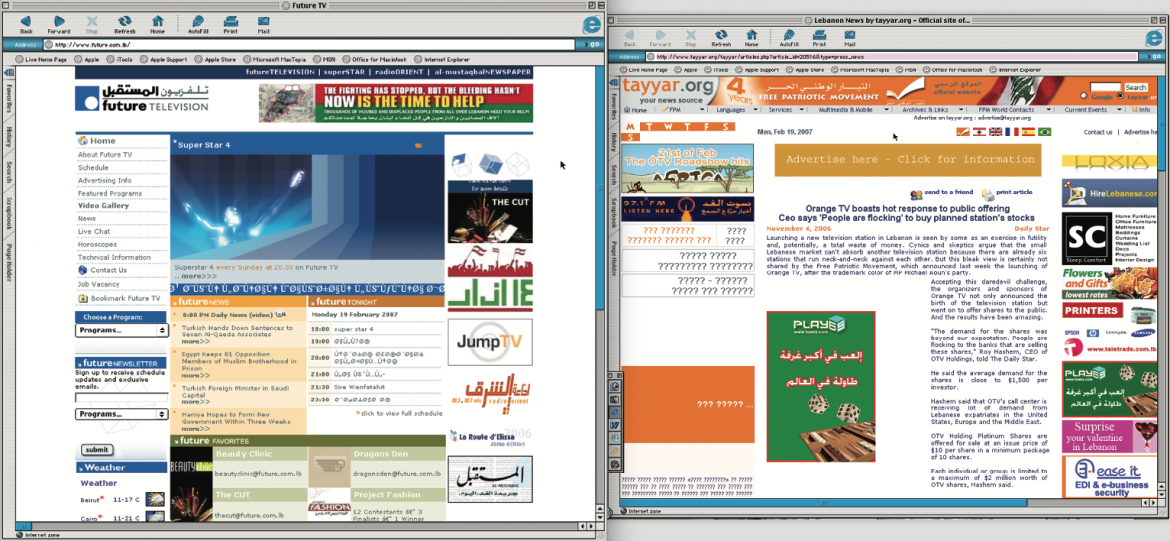The politics that have become so divisive on the Lebanese streets have reached the nation’s TV screens, prompting Lebanon’s media council chief Abdel-Hadi Mahfouz to blame certain channels for stoking sectarianism and engaging in political insults. “Media institutions are strongly asked to ease tensions and avoid transmitting news that might lead to strife,” he urged.
Lebanon has been plunged into a power struggle for three months now, ever since the Hizbullah-led opposition, mainly comprised of Michel Aoun’s Free Patriotic Movement, pitched their tents in downtown Beirut to call for the overthrow of the pro-Western government of Prime Minister Fuad Seniora.
Over the past five weeks the situation has become increasingly tense, following clashes between pro- and anti-government supporters that have left at least seven dead and 190 wounded. Purchases of automatic weapons have also reportedly risen, and in early February the government seized a cache of arms intended for Hizbullah, raising concerns that the sectarian conflict of Lebanon’s 15-year civil war, which ended in 1990, could return.
The two camps
Lebanese TV channels are split between the two respective camps: among major networks, Hizbullah-backed Al Manar TV, the National Broadcasting Network (NBN) and New TV are all pro-opposition, while Future TV and the Lebanese Broadcasting Corporation (LBC) are pro-government.
Although there are more channels critical of the government than pro, in terms of viewership LBC and Future have the lion’s share. The disparity could be minimized, furthermore, if pro-government Murr TV (MTV), which was kicked off the air by the former government in 2002 for criticizing Syria, returns to Lebanese screens.
“Every Lebanese TV channel has a propaganda leaning,” said Habib Battah, managing editor of the Beirut-based Midle East Broadcasters Journal. “Some try to be balanced, but all have their agendas. It’s pretty clear from the content they produce.”
Lebanon’s media has long reflected the country’s political and religious divisions, but sectarianism has become more pronounced following the war between Hizbullah and Israel last year.
“The interesting thing is during the July war the same footage was used on many channels, supporting Hizbullah. So sectarianism has gotten more derisive, more apparent,” said Battah.
Nabil Dajani, a communications professor at the American University of Beirut, agreed that the media are deliberately inflaming sectarianism, but he believes the blame should not lie solely with media outlets.
“You can’t only blame the media—who is behind the media? Politicians. And it’s the government’s fault for allowing the media to get away with it. There is an audiovisual law that prohibits sectarianism, but this government is delinquent and doesn’t step in,” he said.
Propaganda clips
Sectarianism and the trading of political insults are most apparent in news coverage and on talk shows. “An important event or speech will be covered by one set of media, but not by the opposing channels,” observed Battah.
One example was the demonstration on February 14, 2007, attended by hundreds of thousands of Lebanese to mark the second anniversary of the assassination of former Prime Minister Rafik Hariri. Opposition channels gave sparing coverage of the event, while pro-government channels LBC and Future TV gave extensive live coverage. “The media will also use clips taking (political) speeches out of context,” added Battah.
Future TV, owned by Saad Hariri, a member of parliament and the son of the slain former prime minister, and Hizbullah’s Al Manar TV are regarded by Lebanese media observers as particularly sectarian.
“There is intense rivalry between Future and Al Manar, from guests on talk shows to promo propaganda clips,” said Battah.
However, Nadim Munla, chairman and general manager of Future TV, disagreed that the channel is fuelling sectarianism in Lebanon.
“Lebanon is not going through normal times, so to assume or imply international criteria on Lebanese media during abnormal times is unfair,” he said in response to the Media Council’s recent statements. “All of Hassan Nasrallah’s speeches are live on Future, and we have a daily show that sums up all the news channels in Lebanon,” he added.
Moreover, Munla thinks the media council is “hypocritical” to call on TV channels to curb sectarianism, saying the council needs to start with themselves before pointing fingers, as many of its members are involved in the local newspaper market.
“They are political appointees. It is not impartial so I don’t want a lecture on how to do business,” he said.
Nonetheless, he also stated that the media should be at the forefront of change in Lebanon. Indeed, many channels are airing segments aimed at discouraging sectarianism and violence. One such montage on Al Manar showed a clock ticking back from 2007 to 1975, the year the civil war started. Attached to the clock were images from the recent clashes as well as archive footage, ending with the message “Let’s not go back” in Arabic.
A series of adverts encouraging unity around the idea of “I Love Life” have been aired on the pro-government channels, though the organizers of the campaign have stressed that they are an independent civil society gathering. Tensions are not expected to ease any time soon though, with Future TV to launch a 24-hour news channel and Michel Aoun’s party to launch Orange TV (OTV) later this year.
To the Future
Future TV expects to launch its new channel in the next eight to 10 weeks, “unless there are more unseen events,” said Munla.
The new channel is part of a major restructuring at Future, with new content on the entertainment channel and sales directed more at the Gulf region.
“The last pillar of change was to introduce a 24-hour news channel, the main reason being that in the last two years, we allocated more time to cover the news and current affairs,” said Munla.
He said the channel had regularly violated the time allocated to news, which is supposed to be limited to 20% of broadcast time, due to Lebanon’s turbulent politics.
“That affected our viewing base, and adversely affected our entertainment channel, so we will have a 24-hour news channel,” he added.
The new $10 million channel is considered a financial necessity as a result of the July war, with the conflict and the aftermath costing Future over 25% of its project advertising revenue for 2006. By launching the new channel with a state-of-the-art 1,800 m2 studio, Future TV intends to claw back its profits and regional position among the top five networks. Munla said that by the end of the year, Future hopes to return to “pre-recent event levels” and recover its market share by 2008.
News will be primarily Lebanese, but Future will also allocate 20% of coverage to European and Arab affairs, to boost interactivity and understanding between the two regions.
Meanwhile, OTV, the Aounist outlet, is raising funds through a joint stock company open to the public. Starting with a paid-up capital of $2 million, OTV has raised over $10 million via one million $10 shares to establish a terrestrial and satellite channel, and is currently embarking on a regional road show to whip up demand for the remaining shares.
Although OTV claims it will be objective, the channel’s name, recalling the trademark color of Tayyar, and thus the politics of OTV’s mascot, have prompted scepticism among commentators about how neutral it will really be unless there is greater involvement from foreign investors.
Not all bad news
The divergence of opinion on Lebanon’s TV screens may be perceived as fanning the flames of sectarianism and political divergence, but on a practical level, such a kaleidoscope of opinions can also be seen as indicative of a rather healthy, democratic media environment.
“If freedom of expression is measured in how often the opposition is on pro-government stations and vice-versa, we can be considered a highly democratic media industry,” said Munla.
From a certain perspective, Lebanese networks’ relatively open biases may be less dangerous than the illusion of neutrality propagated by channels in other countries. In Lebanon, viewers have the option of getting comprehensive coverage—they just have to watch news broadcasts from both political camps, and remember that the truth lies usually lies somewhere in between.










